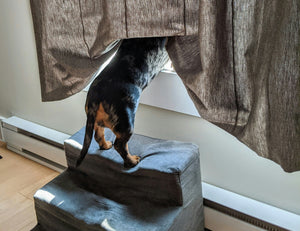3 min read • By Leena Chitnis, Founder, Timberdog®
It’s not the most glamorous subject, but if you’ve ever seen your dog scoot across the carpet or smelled that unmistakable fishy odor, you know what I’m about to talk about. Anal glands. Every dog has them, and while many take care of business on their own, some need a little help. Learning how to clean your dog’s anal glands at home can save you a trip to the vet, keep your dog more comfortable, and yes—protect your furniture.
Before we get into the how, let’s talk about the why. Anal glands are two small sacs located just inside your dog’s anus, sitting roughly at the 4 o’clock and 8 o’clock positions. In the wild, they serve a purpose: releasing a unique scent that marks territory and communicates information to other animals. For most modern dogs, they’re little more than an inconvenience. When the glands don’t empty naturally during bowel movements, they can become full, uncomfortable, or even infected.
The first sign of trouble is often scooting—your dog dragging their rear across the floor to relieve the pressure. You may also notice excessive licking, swelling, or that telltale odor. If you see any of these signs, it’s time to intervene.
Cleaning your dog’s anal glands at home is not difficult, but it does require a bit of preparation. Gather a pair of disposable gloves, unscented baby wipes or a damp paper towel, and a few cotton balls. Having a friend or family member to gently hold your dog steady can make the process smoother. And always choose a calm environment where your dog feels safe.
External Method
Most dog parents who try this at home will use what’s called the external method, which is safer and less invasive than the internal technique used by vets. To do this, gently lift your dog’s tail and place a tissue, gauze pad, or cotton ball over the anus to catch any fluid. With your gloved hand, position your thumb and forefinger just outside the 4 o’clock and 8 o’clock spots, pressing gently inward and upward toward the opening. If the glands are full, you’ll see a small amount of liquid express onto the tissue. Keep the pressure light and steady—too much force can cause pain or injury. Once fluid has been released, wipe the area clean with a fresh tissue or baby wipe, and give your pup plenty of praise and maybe a treat for staying still.
Internal Method
Gently lift your dog’s tail and locate the glands at the 4 and 8 o’clock positions just under the skin. Place a tissue or cotton ball over the area, and with your thumb and forefinger, apply gentle pressure inward and upward. If the glands are full, a small amount of fluid will be released onto the tissue. It may be brownish or yellow, and yes, the smell is unpleasant—but the relief it brings your dog is worth it. Wipe the area clean when you’re done, and reward your pup with a treat for their patience.
It’s important to note that not all dogs need this done at home. Many never require expression, while others may need it every few weeks. If you’re unsure, talk with your veterinarian before trying it yourself. And if you notice blood, pus, or your dog shows signs of pain, stop immediately and seek veterinary care. Infections and abscesses can develop quickly, and those are best treated professionally.
For prevention, focus on diet. Dogs with firm, bulky stools naturally express their glands as they defecate. Adding fiber—like canned pumpkin or vet-recommended supplements—can make a difference. Regular exercise also promotes healthy digestion, which helps keep the system moving.
Cleaning anal glands may not be the highlight of your week, but it’s an important part of caring for a dog who struggles with them. Done carefully and calmly, it can provide instant comfort for your pup and spare you from repeat trips to the clinic. Think of it as another way of showing love: not glamorous, but deeply appreciated. After all, your dog doesn’t care if it’s messy—they just know you’re there to help.
When to See the Vet
If you notice any of the following, skip home care and head straight to your veterinarian:
-
Blood or pus coming from the anal glands
-
Swelling, redness, or extreme tenderness near your dog’s anus
-
A strong odor that doesn’t improve after expression
-
Your dog yelps, resists, or shows signs of pain during the process
-
Repeated scooting or licking even after glands have been emptied
These can all signal infection, abscesses, or other conditions that need professional treatment. When in doubt, always let your vet take the lead.
Photo credit: Myriam Jessier

